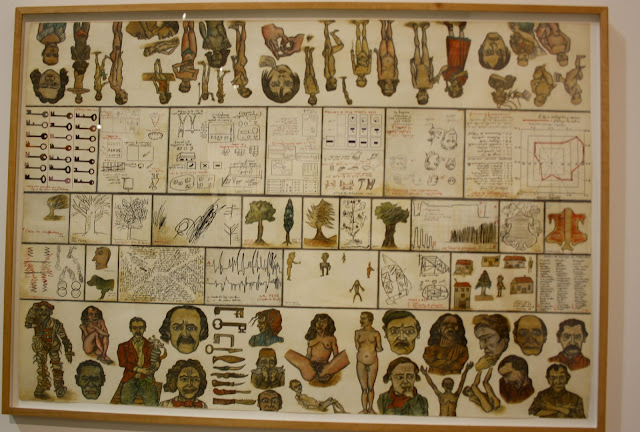Once you find yourself in front of Bouabre's drawings, you get the feeling of having a whole life full of anecdotes spread in fron of your eyes.
He started this collection due to a vision, where he was designated as Cheik Nadro "The who who does not forget". At that pint he began to find his own religion (The order of the prosecuted), he was also keen on recovering an old dialect from the Ivory Coast called Beté.
His divine drawings deal with revelations and the tangible world, this cards are also very useful to get a grasp of the folklore and traditions held in this West African country.
He gathers an amazing collection of hand made index cards, all of them include image and writing, using very simple materials. He started this series in 1982 dividing it into sort of chapters as: "Knowledge of the world" or "myths and symbolism"and "the universe" in which he worked until 88.
This index cards also had an educational purpose, Bouabré was able to teach a lot of members from the order, and also in some Senegal institutes how to talk and write in this old decaying language and bring it back to life.
Yürksel Arslan (1933, Istambul, Turkey)
Arslan drawings are so charged with historical, literary, philosophical, musical, sociological, artistic and even medical references that resemble some kind of world encyclopedia, which fits the Arsenale space perfectly.
But seriously, this artist who was born in Turkey and lived in Paris ever since 1962. He has worked for over 60 years in creating this obsessive congregation of didactic, direct and sometimes freaky drawings.
The technical matter is also very conceptual and coherent with the subjects he chooses. This drawings are made and coloured using potash, honey, egg whites, oil, bone marrow, blood and urine, which give his drawings this organic looking palette.
His work is definitely overstimulating and covers a great extent of his own history as well as the history of man in general. It is definitely universal even if he uses his own childhood memories sometimes, but we can all relate to it to a certain extent. It also covers a great deal of turkish history, even though geographical boundaries where never an issue for Arslan, he seems like the kind of man who would eat the world in one bite, who wants to know everything about everything and would look for it in the darkest corner of the earth, and we're just lucky to be able to take a look at the deeps inside his brain.
Jakun Julian Ziölkowski (1980, Zamosc, Poland)
Ziölkowski's paintings where one of the best discoveries at the biennale personally.
His chaotic, mounstruous, bloody, transgressive, ugly, satiric, lunatic paintings blew my mind really, it is hard not to think of The Bosch or Ensor on acid when looking at them.
The amount of detail and the way it all comes together in a compendium of a very bizarre imaginary that just spout out of his brains.
For the 55th Venice Biennale, Ziölkowski worked on a series of paintings inspired by Jorge Luis Borges The Book of Imaginary Beings. There he gathered material and ideas to create his own beasts and mutants to fill up his paintings, which can take quite a while to look at.
Know a bit more of his work:
http://vimeo.com/25094104
http://www.wmagazine.com/culture/art-and-design/2010/07/jakub_julian_ziolkowski/















No hay comentarios:
Publicar un comentario